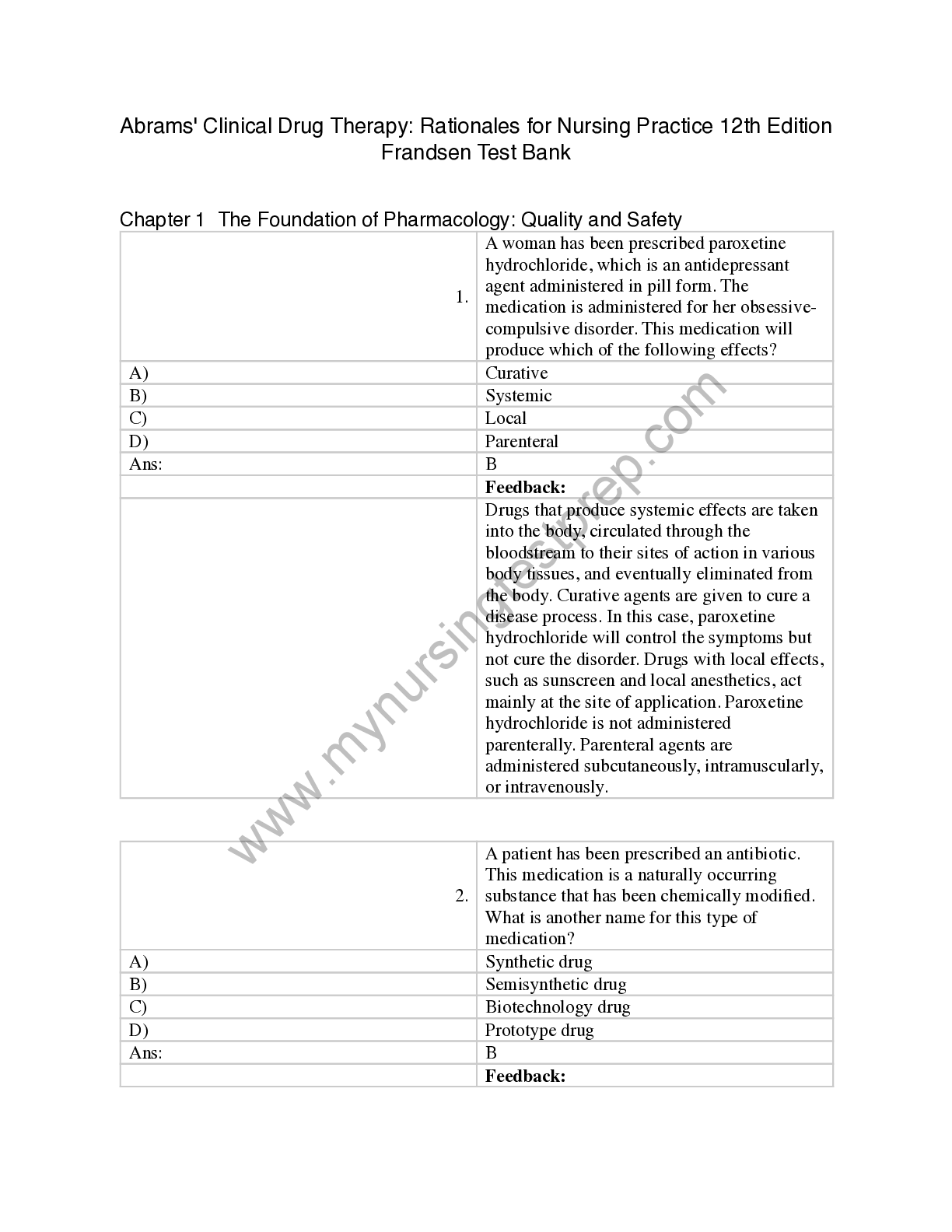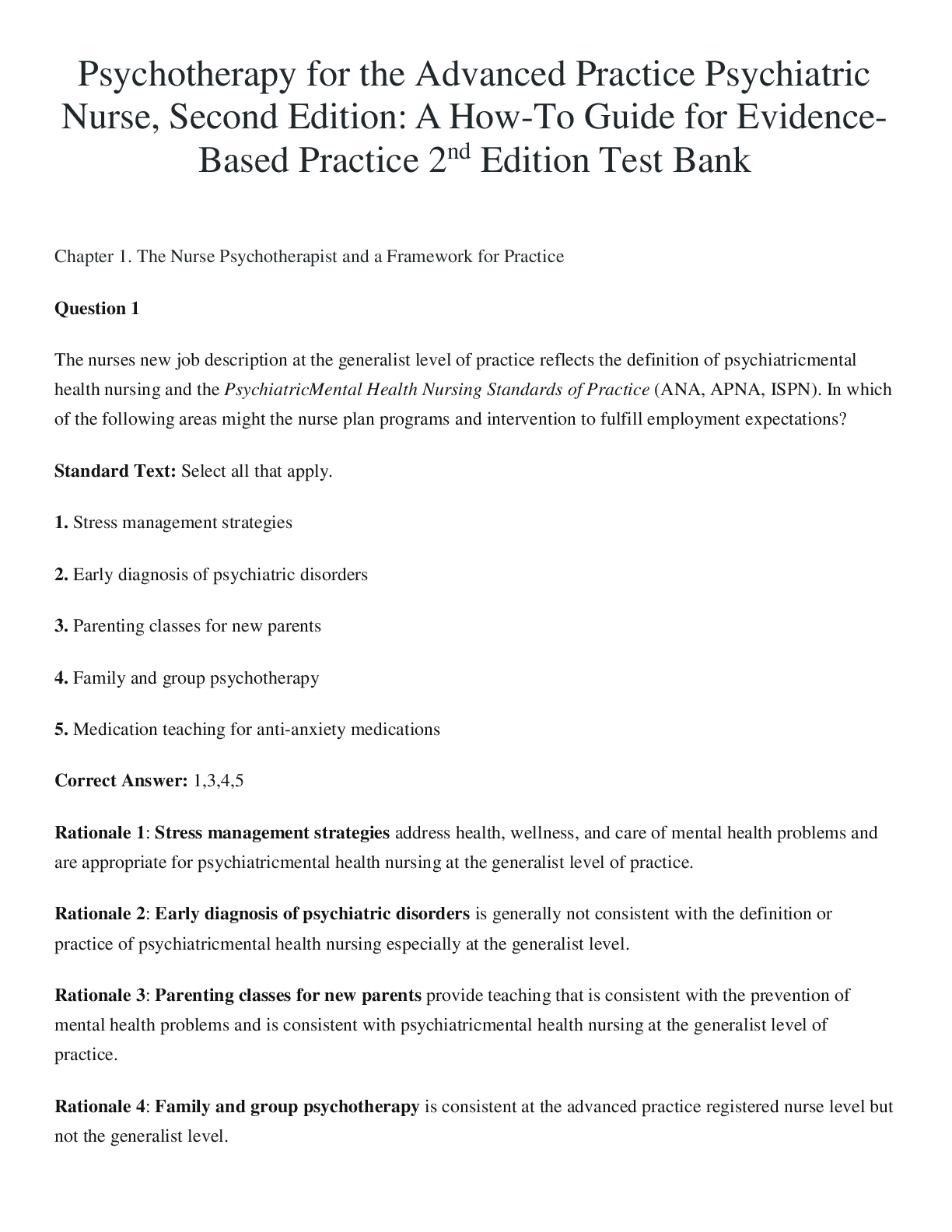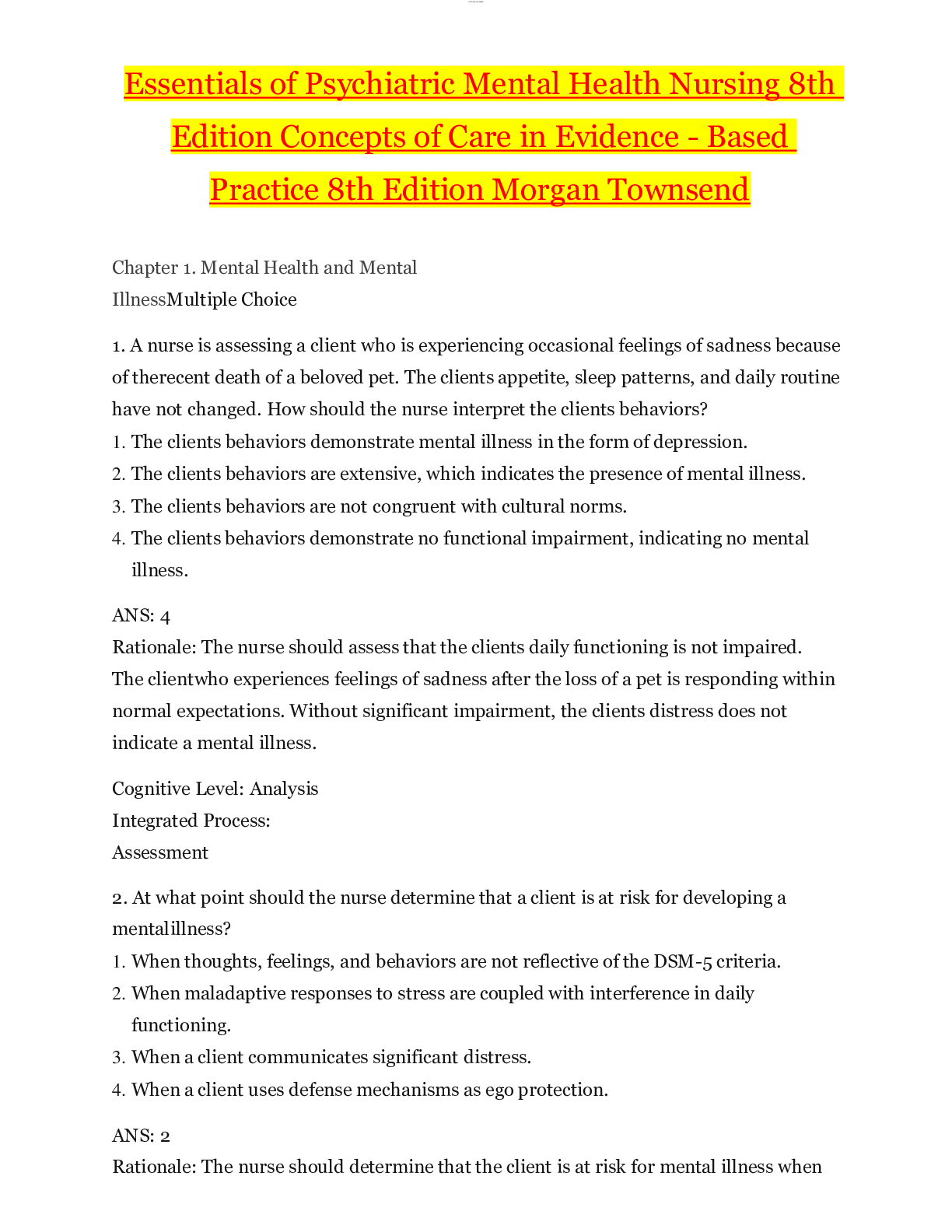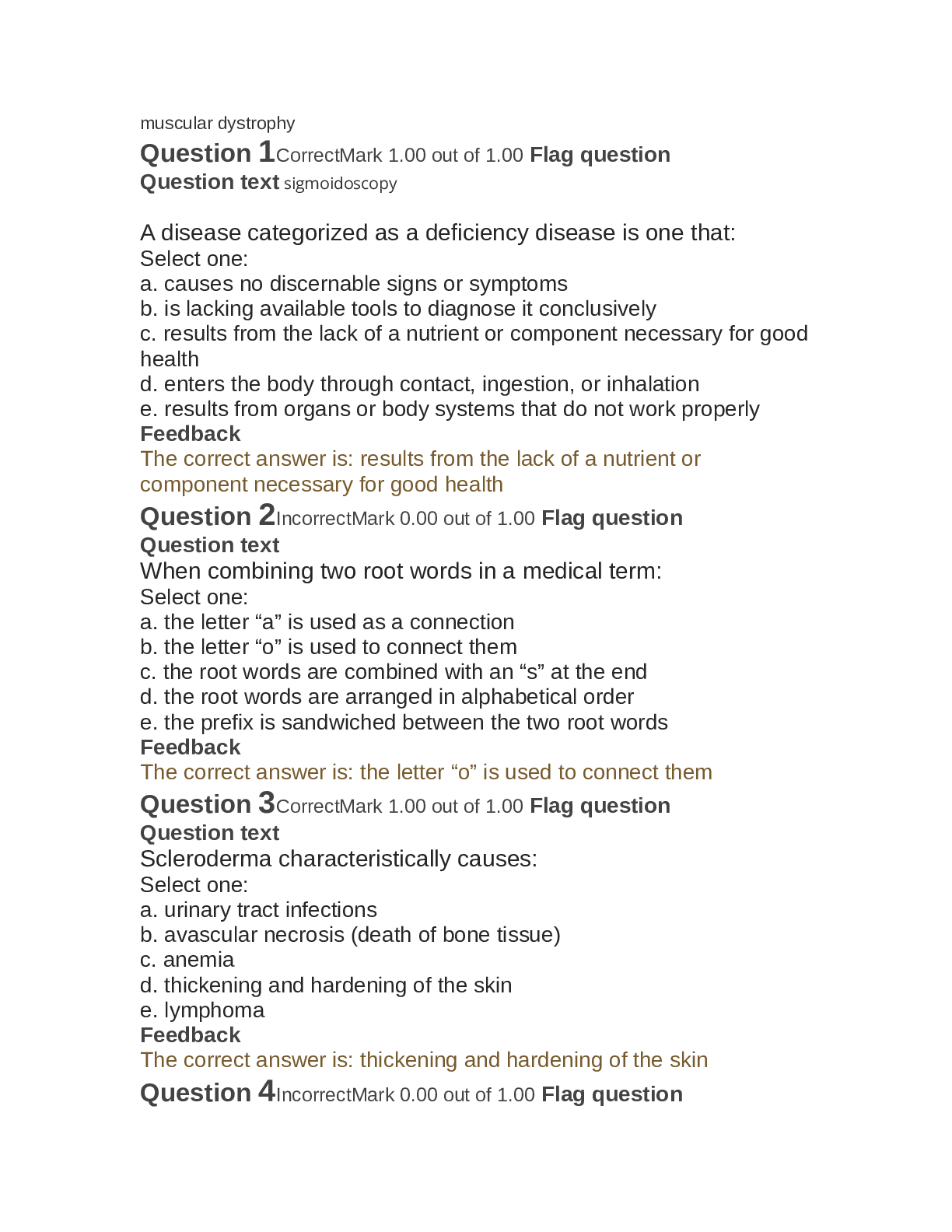*NURSING > TEST BANKS > Bowel-Ostomy Module Exam -Answer Key (Complete Solutions) (All)
Bowel-Ostomy Module Exam -Answer Key (Complete Solutions)
Document Content and Description Below
Potter: Fundamentals of Nursing, 9th Edition Answer Key for Bowel-Ostomy Module Post Tests and Exam (Since questions may be reordered with each usage, the question number in the answer key may not ... correspond to the number that the student reports for a particular quiz item). Lesson 1 Post Test 1. Match the gastrointestinal (GI) structure to its primary function. Correct match: Absorbs, protects, secretes, eliminates Colon Temporarily stores feces until elimination Rectum Receives enzymes from the gallbladder and pancreas to further break down chyme; absorbs nutrients Small intestine Where peristalsis moves food to stomach Esophagus Secretes hydrochloric acid and pepsin; converts bolus of food to chime Stomach Rationale: The esophagus moves food to the stomach by peristaltic action. The stomach secretes hydrochloric acid and pepsin and converts the food bolus to chyme. The small intestine receives enzymes from the gallbladder and pancreas to further break down chyme. Most absorption of nutrients occurs in the small intestine. The primary functions of the colon (i.e., large intestine) are absorption, protection, secretion, and elimination. The rectum temporarily stores feces until elimination. 2. If a patient had to have part of their colon (large intestine) removed, which of the following may result? a) The patient could experience an acid-base imbalance. b) The patient could experience increased amounts of mucus in the stool. c) The patient could experience fluid volume overload with increased absorption. d) Once healed, it would be unlikely for the patient to experience any alteration in elimination. Correct answer: a Rationale: A primary function of the colon is the secretion of bicarbonate for chloride and the release of potassium. Any alteration in the secretory function could result in an acid-base imbalance. A primary function of the colon is the protection of the sensitive tissue lining of the colon through the release of mucus. If a portion of the colon is removed, there would be fewer mucus-secreting cells available. The colon also absorbs water, sodium, and chloride. If less water is absorbed, the patient would be at an increased risk for diarrhea and an electrolyte imbalance. 3. A nurse is admitting a patient to the unit. The nurse is aware that the patient is at increased risk for constipation if the following are present in the patient’s health history or admission assessment? (Select all that apply.) a) The patient is 81 years old. b) The patient reports rare laxative use. c) The patient takes narcotics for chronic back pain. d) The patient eats whole grains; raw fruits; and green, leafy vegetables. e) The patient takes daily iron and calcium supplements. f) The patient reports daily exercise and remains active. Correct answer: a, c, e Rationale: As a person ages, peristalsis slows and increases the risk for constipation. Opiods, iron supplements, and calcium supplements slow colonic action. Laxative misuse is a common cause for constipation. A diet high in animal fats and low in fiber and fluid increases the risk for constipation. Lengthy bed rest or lack of regular exercise are considered risk factors for constipation. 4. The student nurse is studying the order of the GI tract in preparation for an anatomy examination. Which of the following indicates correct understanding? a) mouth, esophagus, stomach, colon, small intestine, anus b) ascending colon, transverse colon, descending colon, sigmoid colon c) stomach, duodenum, ileum, jejunum, cecum, large intestine, rectum d) cecum, small intestine, descending colon, transverse colon, ascending colon Correct answer: b Rationale: The order of the colon is: ascending colon, transverse colon, descending colon, sigmoid colon (then rectum and anus). The cecum is between the small and large intestine. The small intestine (duodenum, jejunum, and ileum) comes before the colon (large intestine). 5. An increase in venous pressure caused by liver disease can result in the development of: a) Hemorrhoids b) Flatulence c) Impaction d) Diarrhea Correct answer: a Rationale: Pressure leading to hemorrhoids can also occur from straining during defecation and from pregnancy. 6. The comatose patient in an intensive care unit (ICU), who has not had a bowel movement in 4 days, suddenly is incontinent of diarrheal stool. What should the nurse suspect? a) Diarrhea as a result of decreased muscle tone b) Impaction c) A vagal response d) Flatulence Correct answer: b Rationale: Prolonged constipation followed by diarrhea that seeps around the impacted stool are symptoms of a fecal impaction. 7. The nurse is monitoring the patient for a possible vagal response while removing a fecal impaction. If the patient would have a vagal response, what would the nurse most likely observe? a) Tachycardia b) Hypertension c) A decrease in heart rate d) A decrease in respirations Correct answer: c Rationale: The nurse should monitor the patient for a decrease in heart rate. Lesson 2 Post Test 1. A patient is scheduled for an abdominal computed tomography (CT) scan. Before the scan, he must receive a cleansing, tap water enema. The nurse should prepare: a) At least 2000 mL of tap water b) 1000 mL or less of tap water c) 5 mL of castile soap and 1500 mL of water d) 180 mL of prepackaged (Fleets) enema solution Correct answer: b Rationale: A tap water enema usually contains 750 to 1000 mL for the adult. If castile soap were to be added, the order would be for a soap suds enema. A Fleets enema is a hypertonic enema, and that would be noted on the order. Since the order is for a clean water enema, the Fleets product would not be appropriate. 2. The physician has ordered a Fleets enema for a patient experiencing constipation. Which of the following actions would require correction? a) The nurse delegates the task to an NAP. b) The nurse removes the protective cap from the rectal tip. c) The nurse squeezes and releases the bottle several times until all of the solution has entered the patient. d) The nurse administers the enema at room temperature or, if too cool, warms the solu [Show More]
Last updated: 2 years ago
Preview 1 out of 16 pages
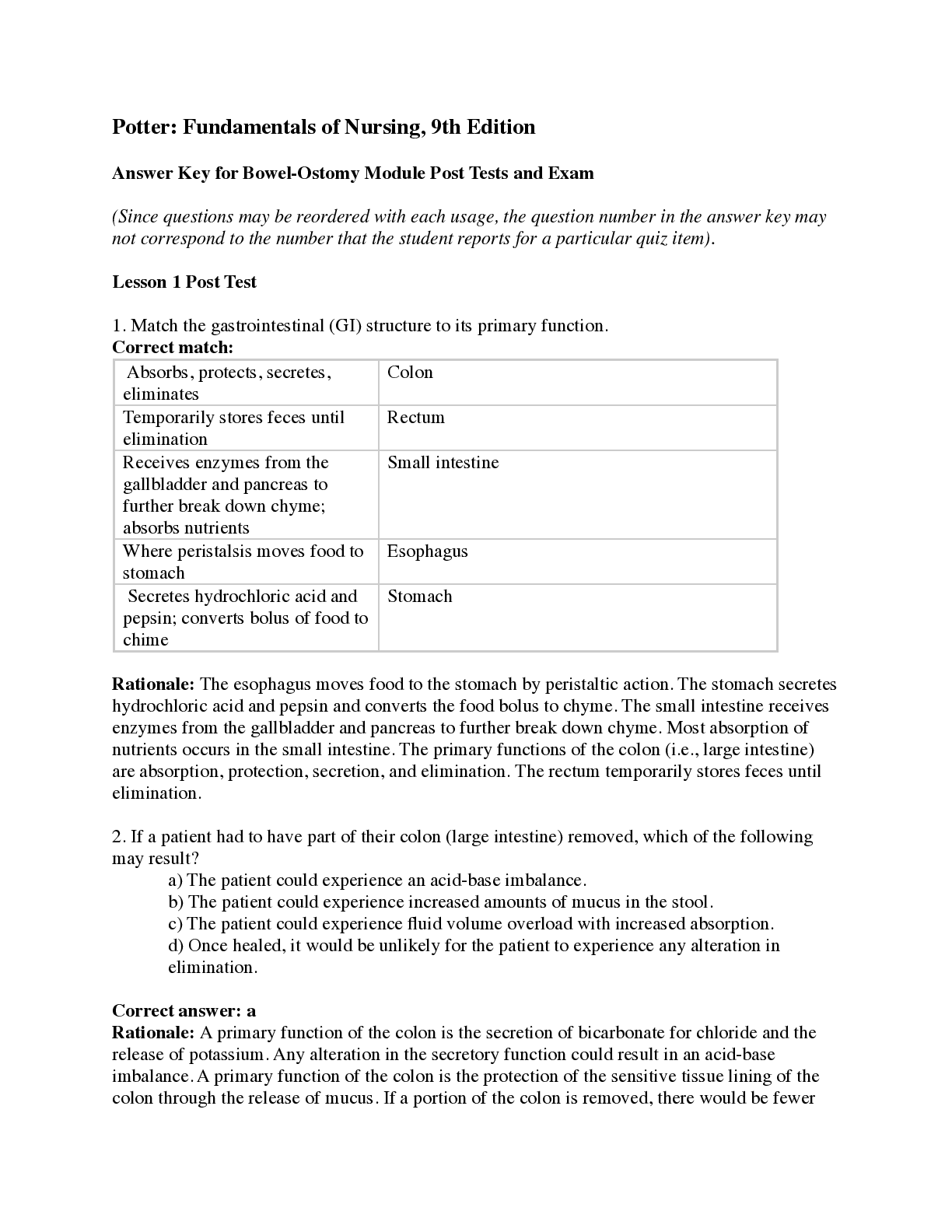
Buy this document to get the full access instantly
Instant Download Access after purchase
Buy NowInstant download
We Accept:

Also available in bundle (1)

Bowel-Ostomy, Urinary Catheterization, Enteral Nutrition Module Exams (with Complete Solutions)
Bowel-Ostomy, Urinary Catheterization, Enteral Nutrition Module Exams (with Complete Solutions)
By jimmydarts 3 years ago
$22
3
Reviews( 0 )
$9.00
Can't find what you want? Try our AI powered Search
Document information
Connected school, study & course
About the document
Uploaded On
Apr 20, 2022
Number of pages
16
Written in
Additional information
This document has been written for:
Uploaded
Apr 20, 2022
Downloads
0
Views
79


